I am studying vibration due to some anecdotal success using the massage gun on fingers. Looking at vibration results I am seeing mixed results. Sometimes it results in degenerative changes but it is likely that vibration needs to be applied correctly to see results. I believe that like Lateral Synovial joint Loading, vibration would be more effective when applied laterally as that would be more effective in driving fluid flow within the bone. I have written about vibration in the past and in one study I saw that when vibration was applied growth plate parameters increased in the vibrated growth but bone length was about the same so it is possible that bone length at skeletal maturity could be longer in the vibrated group.
Attempt to stimulate longitudinal growth in the dog by mechanical vibration
“In animals, right- and left-handedness leads to larger bones on the dominant side.”
“six miniature partly threaded and self-tapping stainless-steel pins 3 mm in diameter (similar to Denham pins used in orthopaedic surgery) were inserted and allowed to penetrate the skin of the medial sides of the forelegs. The incision was loosely sutured between the pins. Stainless-steel bars were fixed to the ends of the protruding pins. These were grooved and cut to match the yokes on the vibrating rig described below.”<it’s possible these surgical incisions are a confounding factor to longitudinal bone growth.
“The amplitude of vibration was not markedly reduced; this was achieved by incorporating a stiff spring web in the system”
Here’s some images of the vibration mechanism:
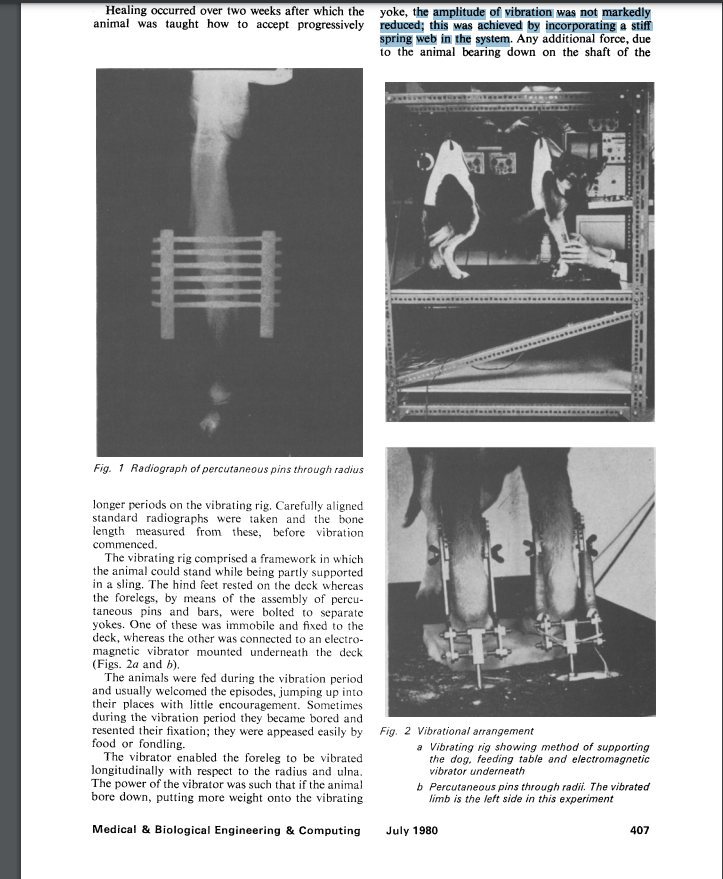
“

“The vibrator enabled the foreleg to be vibrated longitudinally with respect to the radius and ulna”<-so there’s some lateral and torsional loading here.
“In all, seven animals were experimented upon. The first (Dog 1) was experimented upon alone to see if
the study was humane and feasible. Subsequently, and after an encouraging result, four dogs were used
(Dogs 2A-D). In all of these the vibration was sinusoidal, the frequency 20 Hz and the peak-topeak amplitude 4 mm. Finally, in two more dogs (Dogs 3A and B) the same frequency was used but
the amplitude increased to 6 mm”
“As stated above, Dog 1 was used to test the feasibility of the experimental protocol. The result from this single test was an obvious lengthening of the vibrated side{!!!!!} and it indicated to us that
the study should be expanded. Therefore in Group 2, four animals were used, the experimental procedure
being similar except that the daily average vibration period was increased from 1-7h to 2.1h{so it’s possible that these animals did not increase in bone length due to “overtraining”}. The results of Group 2 were disappointing in that, in two dogs, there was actually a small reduction in growth in length on the vibrated side. Group 3 was a more vigorous test in which the amplitude of vibration was increased to 6-8 mm (peak-to-peak). The dogs tolerated this well but, again, no increase occurred. (In one other animal, pins were inserted on one side only and here there was a slight increase in length of both radius and ulna compared with the undisturbed side{so yes this means that the pins are a confounding variable}.)”
Here’s the exciting increase in bone length:
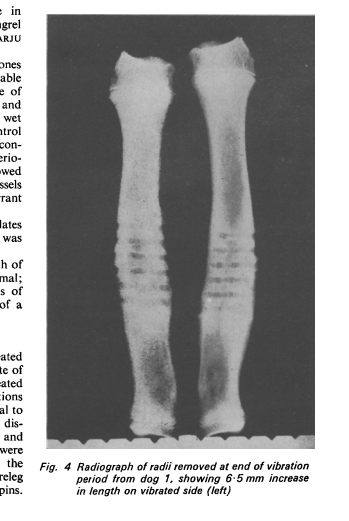
That is frigging massive. The bone looks a lot different in the length increased bone.
“The arteriograms obtained from Dog 1 before sacrifice showed a slight real increase in calibre of the digital vessels on the vibrated side. The difference did not warrant further arteriograms.”<-So vascularity could contribute to part of the increase?
“Histological examination of the growth plates and of the cortical bone at the site of the pins was unremarkable.”<-this is huge as it means that the increase in size could be unrelated to the growth plate i.e. meaning that it could work post skeletal maturity!!!!!
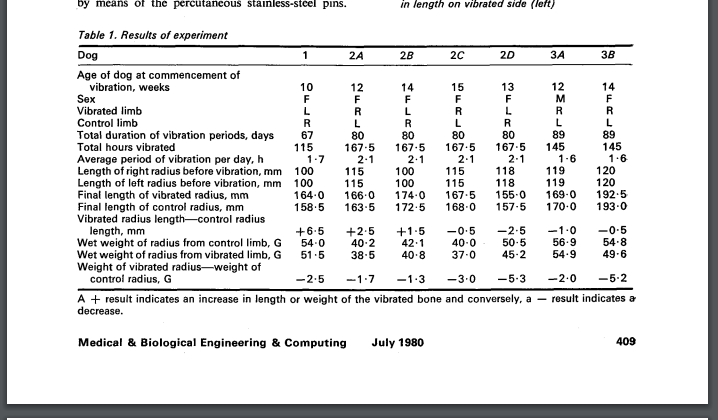
“The forces were transferred from the radius through the elbow and wrist joints to the arm and paw
respectively. In order to reach these joints, the forces must have passed through the upper and lower
growth plate respectively of the radius, and these will have been subjected to alternating compressive
and distracting forces.”<-one possibility is that the vibration may have induced longitudinal bone growth on the bone but damaged the growth plates. In skeletally mature individuals this would not be an issue as they do not have growth plates. Thus, it would be worthwhile to repeat the experiment on skeletally mature animals.
Here’s the study that was cited in the paper as being about vibration:
The effects of mechanical vibration on bone development in the rat
The study found bone decreased calcium content. This could play a role as the hardness of bone impedes intersititial(longitudinal) bone growth.
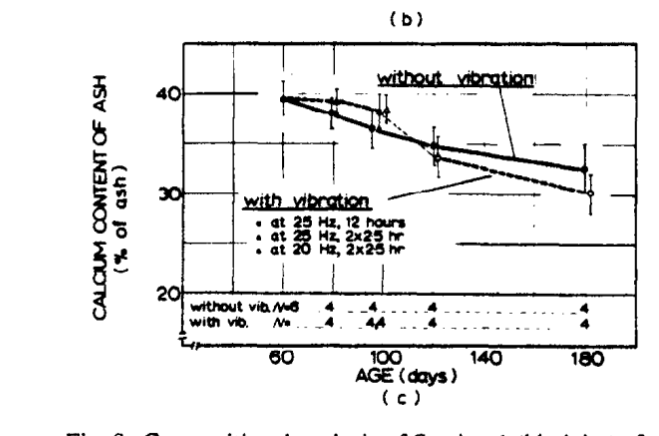
And this study too finds slight increase in longitudinal growth!:
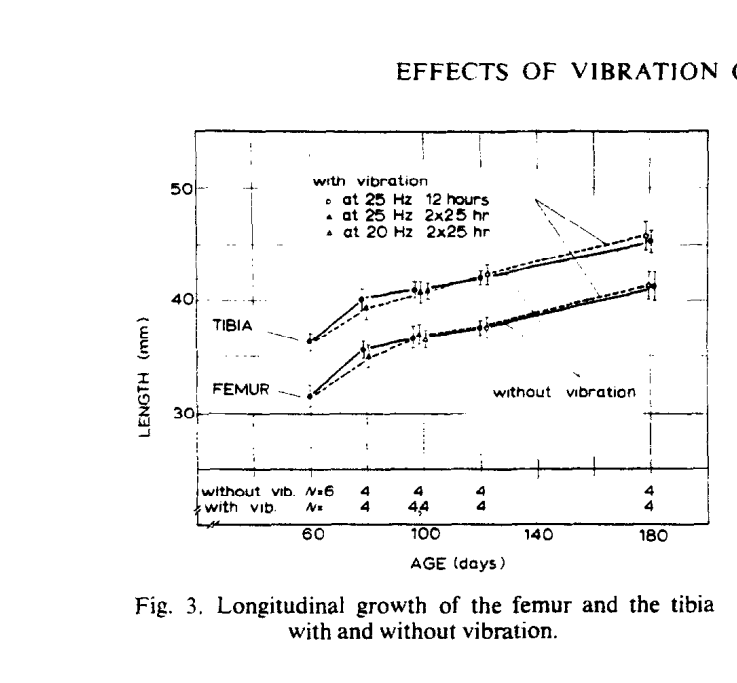
“In one series of experiments. lasting for 5 weeks. 20 and 25 Hz was applied for 2.5 hr twice daily with 6
hr of rest intervening. In another series, which lasted for 4 months. the animals received 25 Hz for 12 hr each day without interruption”
So another result that indicates that perhaps by optimizing the vibration stimulus longitudinal bone growth is possible. Also interesting to note that in this study the non vibrated groups grow faster at first. I don’t know what conclusion to draw from that but it is something to explore.
So overall there is not a smoking gun to vibration and longitudinal bone growth but there is some smoke. So it is worth it to keep testing the massage gun method to see if the anecdotal reports continue to have promise. And it is entirely possible that once the method is optimized the results will be stronger than what is reported here.
